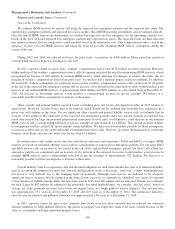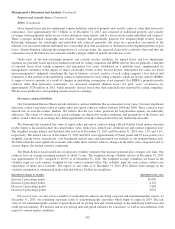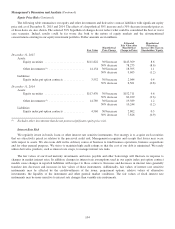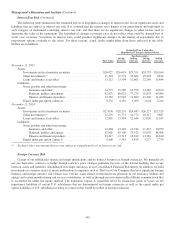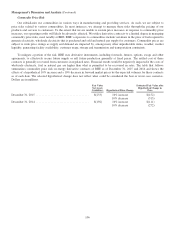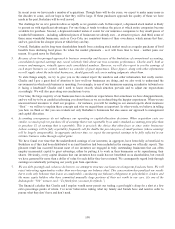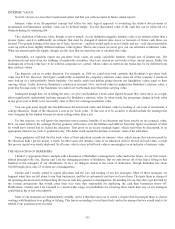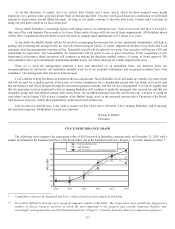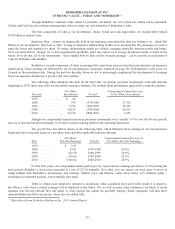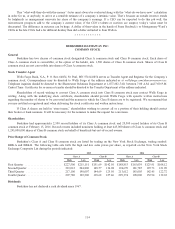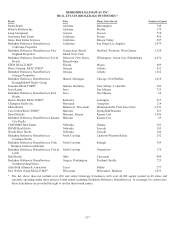Berkshire Hathaway 2015 Annual Report Download - page 111
Download and view the complete annual report
Please find page 111 of the 2015 Berkshire Hathaway annual report below. You can navigate through the pages in the report by either clicking on the pages listed below, or by using the keyword search tool below to find specific information within the annual report.Besides, Berkshire has access to two low-cost, non-perilous sources of leverage that allow us to safely own far more
assets than our equity capital alone would permit: deferred taxes and “float,” the funds of others that our insurance
business holds because it receives premiums before needing to pay out losses. Both of these funding sources have grown
rapidly and now total about $151 billion.
Better yet, this funding to date has often been cost-free. Deferred tax liabilities bear no interest. And as long as we can
break even in our insurance underwriting the cost of the float developed from that operation is zero. Neither item, of
course, is equity; these are real liabilities. But they are liabilities without covenants or due dates attached to them. In
effect, they give us the benefit of debt – an ability to have more assets working for us – but saddle us with none of its
drawbacks.
Of course, there is no guarantee that we can obtain our float in the future at no cost. But we feel our chances of attaining
that goal are as good as those of anyone in the insurance business. Not only have we reached the goal in the past (despite a
number of important mistakes by your Chairman), our 1996 acquisition of GEICO, materially improved our prospects for
getting there in the future.
In our present configuration (2015) we expect additional borrowings to be concentrated in our utilities and railroad
businesses, loans that are non-recourse to Berkshire. Here, we will favor long-term, fixed-rate loans.
8. A managerial “wish list” will not be filled at shareholder expense. We will not diversify by purchasing entire businesses
at control prices that ignore long-term economic consequences to our shareholders. We will only do with your money
what we would do with our own, weighing fully the values you can obtain by diversifying your own portfolios through
direct purchases in the stock market.
Charlie and I are interested only in acquisitions that we believe will raise the per-share intrinsic value of Berkshire’s
stock. The size of our paychecks or our offices will never be related to the size of Berkshire’s balance sheet.
9. We feel noble intentions should be checked periodically against results. We test the wisdom of retaining earnings by
assessing whether retention, over time, delivers shareholders at least $1 of market value for each $1 retained. To date,
this test has been met. We will continue to apply it on a five-year rolling basis. As our net worth grows, it is more difficult
to use retained earnings wisely.
I should have written the “five-year rolling basis” sentence differently, an error I didn’t realize until I received a question
about this subject at the 2009 annual meeting.
When the stock market has declined sharply over a five-year stretch, our market-price premium to book value has
sometimes shrunk. And when that happens, we fail the test as I improperly formulated it. In fact, we fell far short as early
as 1971-75, well before I wrote this principle in 1983.
The five-year test should be: (1) during the period did our book-value gain exceed the performance of the S&P; and
(2) did our stock consistently sell at a premium to book, meaning that every $1 of retained earnings was always worth
more than $1? If these tests are met, retaining earnings has made sense.
10. We will issue common stock only when we receive as much in business value as we give. This rule applies to all forms of
issuance – not only mergers or public stock offerings, but stock-for-debt swaps, stock options, and convertible securities
as well. We will not sell small portions of your company – and that is what the issuance of shares amounts to – on a basis
inconsistent with the value of the entire enterprise.
When we sold the Class B shares in 1996, we stated that Berkshire stock was not undervalued – and some people found
that shocking. That reaction was not well-founded. Shock should have registered instead had we issued shares when our
stock was undervalued. Managements that say or imply during a public offering that their stock is undervalued are usually
being economical with the truth or uneconomical with their existing shareholders’ money: Owners unfairly lose if their
managers deliberately sell assets for 80¢ that in fact are worth $1. We didn’t commit that kind of crime in our offering of
Class B shares and we never will. (We did not, however, say at the time of the sale that our stock was overvalued, though
many media have reported that we did.)
11. You should be fully aware of one attitude Charlie and I share that hurts our financial performance: Regardless of price,
we have no interest at all in selling any good businesses that Berkshire owns. We are also very reluctant to sell sub-par
businesses as long as we expect them to generate at least some cash and as long as we feel good about their managers
and labor relations. We hope not to repeat the capital-allocation mistakes that led us into such sub-par businesses. And
we react with great caution to suggestions that our poor businesses can be restored to satisfactory profitability by major
capital expenditures. (The projections will be dazzling and the advocates sincere, but, in the end, major additional
investment in a terrible industry usually is about as rewarding as struggling in quicksand.) Nevertheless, gin rummy
managerial behavior (discard your least promising business at each turn) is not our style. We would rather have our
overall results penalized a bit than engage in that kind of behavior.
109



